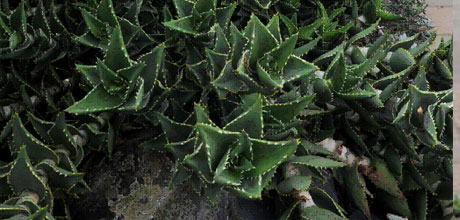Arid Environment Results in Wacky Appearance
This article was first published on 08 Apr 2011.

Succulent plants
Patterns in nature endlessly fascinate me, which is why I’m drawn to the beautiful forms of succulent plants. To me, the perfect geometric patterns of succulents echo the intricacies of universal shapes like spirals, mandalas, cobwebs and nebulae.
The western wing of the winter garden glasshouse at Dunedin Botanic Garden is home to a weird and wonderful selection of intriguing succulents. Here you can check out a wide variety of shapes, sizes and growth habits – or if you’ve got an overactive imagination like mine, you might see a party of bizarre creatures reminiscent of desert-dwelling starfish, statuesque aliens with fearsome spines, and zig-zagging worms from an Escher painting.
Most of the succulent species on display in the glasshouse come from deserts in Southern Africa and America, so they are pretty tough. In these harsh, arid environments, they have adapted various ways of quickly absorbing the tiny amounts of water at their disposal, and storing it in their swollen leaves and stems. The result is a downright crazy array of different succulent shapes and styles.
Cultivating succulents is, for the most part, pretty easy and even the most amateur of growers can start a collection on a sunny windowsill. As long as you give your plants a free draining soil mix, and water them now and then, they will flourish. Watching these unique plants grow and multiply is a pleasure and eventually they might astonish you with a flower.
Kate Caldwell is a horticultural apprentice at Dunedin Botanic Garden


